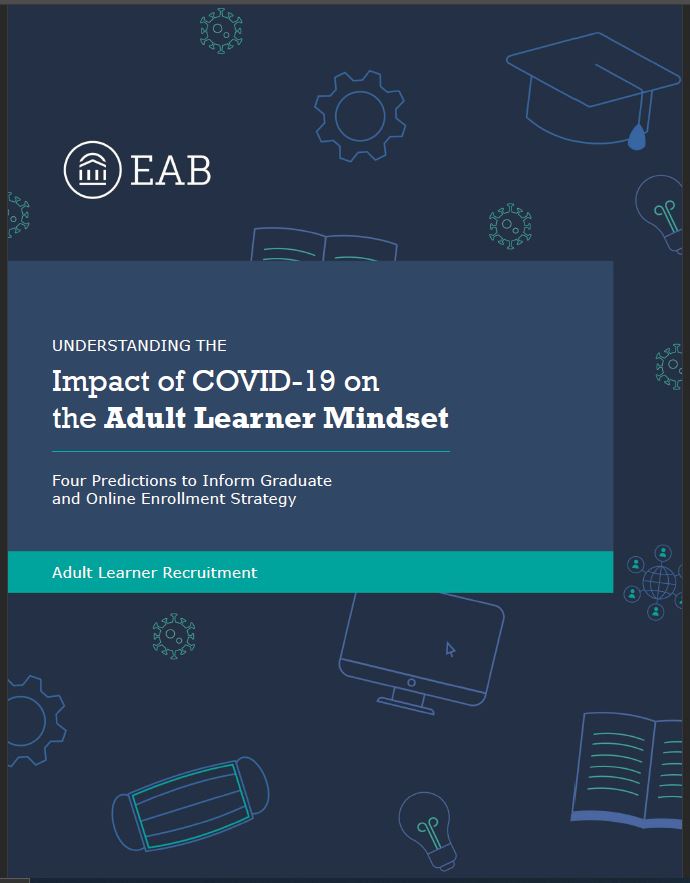You did everything right.
Labor market analysis to confirm employer demand—check.
A competitor scan to verify a lack of local competition—check.
Research to confirm student interest in your program—check.
And yet, your program that seemed destined to achieve its enrollment and revenue goals struggles to get off the ground.
Often, your graduate, professional, adult, and degree completion programs that fail to meet enrollment expectations aren’t designed and marketed with adult learners in mind. The truth is, adult learners’ behavior and mindset are evolving, and it can be challenging to scale program and marketing innovations to meet their needs. Here are three proven strategies to ensure you are adapting your program development and marketing strategies to recruit adult learners.
1. Optimize your programs to meet adult learners’ needs
I’m a marketer by trade, but I will be the first to admit marketing can’t solve all your enrollment challenges. No matter how good your marketing is, you won’t meet your full enrollment potential if your programs aren’t tailored to meet adult learners’ needs. Prospective adult learners, whether they are interested in graduate or degree completion programs, seek flexible, convenient options. And they seek programs that will provide a return on their investment, such as career advancement or career change opportunities.
To ensure your programs meet students’ needs and goals, start by confirming your programs are aligned to market demand. Do your programs confer the skills students need to succeed in the workforce? How does your curriculum and program structure stack up against your competitors’? And how does your program mix align with your institution’s mission and growth goals?
Our researchers have spent years (and 7,000+ custom research studies) perfecting the art and science of assessing program viability based on labor market demand, competitors’ offerings, and adult learners’ shifting priorities. But making meaningful changes to your portfolio and growth strategy often requires consensus across campus. Our Adult Learner Recruitment partners have found success combining program viability analyses with workshops that bring together their team, the president’s cabinet, and often, the board of trustees with EAB experts.
2. Build a robust best-fit prospect audience through a mix of traditional and innovative sources
Gone are the days of relying primarily on test-taker lists to find prospective adult learners. Seventy percent of today’s adult learners are “stealth,” or unknown to your institution until they start an application. And even before COVID-19 canceled test dates, fewer and fewer students were opting to take admissions tests and submit scores.
Expanding your prospect pool to target all possible right-fit students requires a sophisticated and multipronged audience generation strategy. In addition to generating a highly targeted list of test-takers, ensure you’re targeting pre-testers. Across 110 partner institutions, we’ve found a 45% higher yield rate from pre-testers as opposed to test takers. Make sure you’re including your young alumni and current undergrads, who are most familiar with all your institution has to offer, in your audience strategy. And don’t give up on students who inquired months or years ago but never ended up applying to your institution. We’ve found 96% of inquiries apply within three years of initial inquiry, so continue to engage with students even if they don’t respond immediately.
To further expand their potential student audience, our Adult Learner Recruitment partners have had success building a custom student persona and using the persona to inform marketing messages. Each persona is based on detailed demographic and psychographic data, coupled with their lifestyle and purchasing behaviors. And because the persona is specific to their institution, it sheds valuable insight into what makes their adult learner population so unique. While creating a student persona is a new tactic in higher ed marketing, it’s been a foundational marketing strategy at corporations like Coca Cola and Nike.
Digital targeting throughout students’ journey to enrollment is also critical to a successful recruitment strategy. While you can and should target students from owned or purchased lists on digital channels, restrictions on list-based advertising mean marketing leaders need to find other ways to reach students. At EAB, we create lists based on first-party data to target audiences likely already interested in your programs on channels like Facebook and LinkedIn. From there, prospective students receive ads designed to build awareness, encourage consideration of a school or program, or create a sense of urgency to apply, depending n where they are in the enrollment funnel.
As competition intensifies, it’s important to keep innovating on your audience generation strategy. This year, our targeting experts are testing opportunities to target prospective students from several new sources and keep our partners on the cutting edge. Make sure your team runs towards opportunities to experiment with new and different audience generation tactics.
3. Deploy omnichannel marketing campaigns based on student intent
Once you’ve identified right-fit prospects, you need to ensure you are delivering the right message at the right time. But that’s easier said than done. Each prospective student’s intent and timeline to enrollment varies from the next. And in a day and age when students are accustomed to highly personalized, responsive marketing, a one-size-fits-all approach won’t generate the results you’re looking for.
To make sure you’re delivering the right message at the right time, market according to student intent marketing. Intent marketing relies on personalization and real-time responsiveness to student behavior. So, when a student sends a digital signal that shows interest in going back to school, marketers respond with communications that reflect a true understanding of the prospect’s needs and intentions. At EAB, we also deploy quick, one- or two-question surveys to help understand students’ motivations and concerns—and tailor marketing messages accordingly.
3x
Intent marketing is especially effective when it informs your marketing strategy across all channels, including digital ads, email, and direct mail. Our team of copy writers, creatives, and data analysts also apply intent marketing to develop personalized content gives and newsletters to help students stay engaged throughout their journey to enrollment. We’ve found prospects who download content gives are 27% more likely to apply.
I’ve been so excited by all the results schools have achieved using these strategies. But to continue to grow, it will only become more important for enrollment leaders to scale these efforts and continue to innovate.
You may also like
What the 2008 Recession tells us about the future of the adult degree completer market
For many degree completers, the thing that made them re-enroll was a major shift in life circumstances: a catalytic life event. But can a nationwide crisis like COVID-19 become a shared catalyst for millions of potential degree completers?
COVID-19 is creating a new “lost class.” Here’s how professional and graduate education can help
See strategies leaders of professional and graduate education programs can use to serve and support recent grads in finding lifelong careers.



